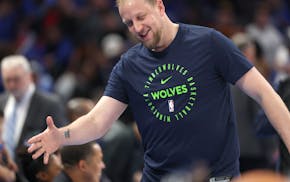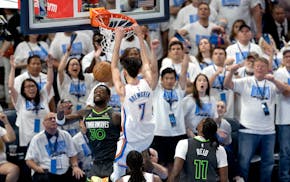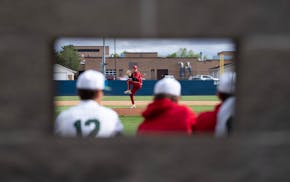Irwin Smallwood was a golf writer, sports editor and editor for the Greensboro (N.C.) News & Record for nearly a half century. For most of that time, Cleola Hudson worked for the Smallwood family as a housekeeper and other duties.
Segregation still had a strong hold on the South in the early 1960s. "We weren't really covering the black high schools at that time," said Smallwood, now 88. "Mrs. Hudson told me a few times that she had a son who played basketball, and she thought he was pretty good at it, and that I might want to go to Dudley High School and watch him.
"I did that, and her son was bringing the ball up the court, and making shots, and getting above everyone for rebounds, and I went back to the office and said, 'Gentlemen, there's quite a basketball player over at Dudley named Lou Hudson.'
"Bones McKinney, the coach at Wake Forest, would have loved to have Lou, but it was just a couple of years too early for that down here. Bones told his good friend John Kundla about Lou, and that's how he wound up at Minnesota."
Lou Hudson, among the greatest of all Gophers basketball players, died Friday at age 69 while in hospice care in Atlanta. He had suffered a stroke on March 24.
Hudson had a previous stroke in 2005 that had left him needing a wheelchair or other aids to get around.
"I talked to Lou a couple of months ago and he was rehabbing every day and feeling good about the progress he was making," Smallwood said. "He said, 'We're going to play a round of golf before this summer is over.' "
Mardi Hudson, Lou's wife, said he suffered the stroke while lifting arm weights on the deck of his place in Atlanta. "The terrible thing about all of this has been to see him there in the hospice, looking so darn good," she said. "Lou had been working out four, five times a day, getting stronger."
Mardi Smith was from Windom, Minn., and first met Lou when he was a student at Minnesota and she was a student at Mankato State in the mid-1960s. Two decades later, Mardi was living in Park City, Utah. Lou was working on the Atlanta Hawks telecasts as an analyst, he connected with Mardi for a dinner date and they wound up getting married in 1987.
Lou became a prominent citizen in Park City and, in 1993, he was elected to the city council with the help of campaign signs that read, "Sweet Lou for You."
There was another Sweet Lou, Nanne, the hockey player from the Soo, on the University of Minnesota campus when Hudson arrived in the summer of 1962. More than Sweet Lou, Hudson was known as the lead name in the Minnesota basketball partnership of "Hudson, Clark and Yates."
New to town
Hudson, Archie Clark and Don Yates were the first three black players to receive basketball scholarships to Minnesota, through the outreach of coach John Kundla and his assistant, Glen Reed.
"I was 17 when I got to Minnesota," Hudson said in a 1994 interview. "I had been out of high school less than a week. Clark and Yates did not arrive until later in the summer. It was amazing, for a kid who had lived with segregation in North Carolina, to be on that campus …
"I would ride the bus down to Hennepin Avenue once in a while, just to run into another black person and maybe talk for a few minutes."
Freshmen were not eligible for varsity competition at the time. Reed was the varsity assistant and also the freshman coach in the winter of 1962-63.
"We would bring the freshmen over to scrimmage the varsity," Reed said in 1999. "If the varsity tried to press, Hudson, Clark or Yates would be shooting a layup a couple of seconds later."
Hudson was a sleek 6-foot-5 forward from Greensboro and came to the Gophers because of a Kundla-McKinney connection dating to the NBA. Yates was a 6-foot-3 guard from Uniontown, Pa., the town from where the Gophers had recruited quarterback Sandy Stephens. Clark was a 6-foot-2 guard who was serving in the Air Force; he came on a recommendation of Reed's friend Buzz Bennett, who was the basketball coach at Andrews Air Force Base.
Grabbing headlines
There was some attention paid to the exploits of Hudson, Yates and Clark on the freshmen team, but Gophers basketball as a whole was only a big deal occasionally on the Twin Cities sports scene.
The first Big Ten game for Hudson, Yates and Clark was on Jan. 4, 1964, vs. Purdue. The crowd in Williams Arena was 6,461, even with the buildup of Hudson going against another noted sophomore, Purdue's Dave Schellhase.
"My main memory of Lou Hudson is simple: 'What a great player,' " Schellhase said in a recent phone interview. "Lou shot the ball perfectly … his release for a player 6-foot-5 allowed him to shoot the ball over people. That's what made him so outstanding later in the NBA, the ability to move and that perfect form on his jump shot."
The Gophers beat Purdue 97-93 in that 1964 Big Ten opener. Hudson scored 36 and Schellhase 29, with Hudson scoring 24 in the second half after cutting his scalp open in the first half.
"Lou Hudson played quite a few amazing games for us, but I remember that game against Purdue more than any other," Kundla said. "He hit his head on the backboard in the first half and cut open his scalp. I thought he was done for the game, Then, he came out in the second half and won it for us.
"It was a game that created the Hudson rule, The colleges were ordered to put a strip on the bottom of the backboards after Lou cut his head. People remember Lou as a great shooter, but at 6-5 he also could jump out of the gym."
Overcoming injury
The Gophers were 10-4 in the Big Ten in Hudson's first two varsity seasons. Only the Big Ten champion qualified for the NCAA tournament, and the faculty overseeing athletics at Minnesota would not allow the Gophers to accept an invitation to go to New York for the NIT.
Lou was an All-America as a junior in 1965, averaging 24.8 points and 10.7 rebounds. There were big expectations for the 1965-66 season, before Yates was ruled academically ineligible and Hudson broke his right wrist in the fourth game of the season vs. Creighton.
"Lou was undercut on a layup," Kundla said. "I don't know if it was intentional, but I almost cried."
The Gophers put a cast on his right hand and Hudson averaged 14 points in the Big Ten shooting lefthanded.
"Lou used that club on his right hand as a weapon," Schellhase said. "He might have denied it, but you were beat up after a game against Lou and his club."
The Gophers went 7-7 that season in the Big Ten. Hudson was the fourth overall selection in the NBA draft by the St. Louis Hawks. The Hawks moved to Atlanta. That's where he became "Sweet Lou," for that jump shot, and as a six-time NBA All-Star.
Hudson had two children, Louis Jr. and Adrienne, from his first marriage. The family suffered a tragedy in 1996, when Louis Jr. — a basketball player at Riverwood High School in Atlanta — died at age 18 due to a blood clot in his lung.
"His son's death hurt him so much," Mardi Hudson said. "Lou was able to come back from that emotionally only because he's a rock. And his daughter, Adrienne, through losing her brother, and her dad's health problems … she's the same. In her case, the apple did not fall far from the tree."
Peer praise
Charlie Sanders was a couple of years behind Hudson at Dudley High School in Greensboro. Sanders came to Minnesota to play football in 1964, as segregation was nearing the end of its grip on the South. Sanders is in the Pro Football Hall of Fame for his career as a tight end with the Detroit Lions.
Hudson was his quarterback at Dudley. Sanders recalled that time to Jeff Mills of the Greensboro newspaper in late March:
"Football, basketball, baseball, track … Lou could do everything well. He was instrumental in my pursuing athletics. When I saw Lou Hudson play, that's when I made up my mind I wanted to be like him.
"He was mild-mannered and even-keeled. I never once saw him lose his temper. He was a guy you wanted to be around."
Hudson's No. 14 was retired by the Gophers in 1994 and he is a member of the school's Hall of Fame.
Atlanta Hawks co-owner Michael Gearon issued this statement: "Lou Hudson holds a special place in the Hawks family, in the hearts of our fans and in the history of our club. As a fan growing up with this team, I'm fortunate to say I was able to see almost every game Sweet Lou played as a member of the Hawks. He was an integral part of successful Hawks teams for over a decade, and is deservedly recognized with the ultimate symbol of his significance to the franchise with the number 23 hanging inside Philips Arena. On behalf of the Hawks organization, I'd like to extend condolences to Lou's family and friends."
Patrick Reusse can be heard 3-6 p.m. weekdays on AM-1500. preusse@startribune.com

Reusse: Bobblehead-driven Target Field crowd sticks around for another walk-off win

Reusse: From the lovable land Down Under, Ingles serves as statesman for Timberwolves

Reusse: Timberwolves are shown clearly the Thunder are a cut above

Reusse: Baseball Day Minnesota presents the game's many aspects but especially agony and ecstasy

